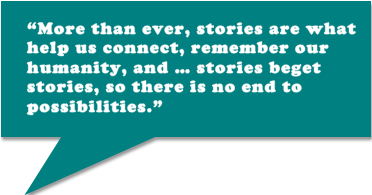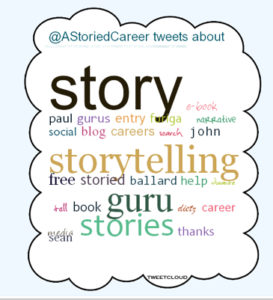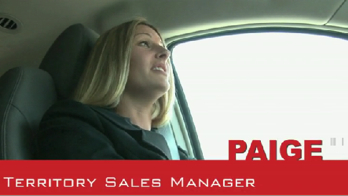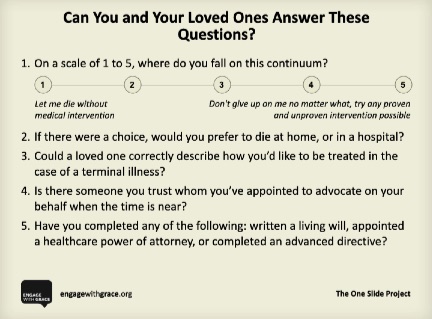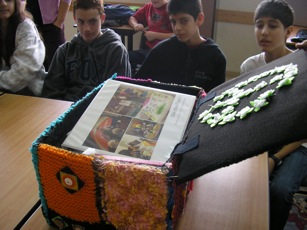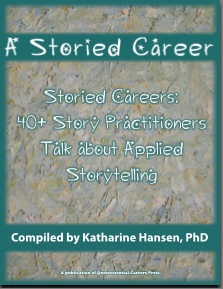
I’ve completed two series of Q&As with story practitioners, the most recent in August, followed by the free e-book compilation of Q&As, Storied Careers: 40+ Story Practitioners Talk About Applied Storytelling. Plenty of fascinating practitioners are still out there uninterviewed, so I will continue to bring you these Q&As from time to time. I learned of Judy Rosemarin while researching my most recent book, Top Notch Executive Interviews. Judy joins me, Terrence Gargiulo, Rob Sullivan, and a handful of others as strong advocates for storytelling in the job search. This Q&A will appear over the next several days.
Bio: For more than 25 years, Judy has coached senior leaders in effective  communication so that they can influence and impact others in the most productive ways. With her unique one on one coaching style, combining her experience in writing, acting and teaching, Judy has helped thousands of executives become more confident and competent in their roles. As a storytelling coach, she teaches executives in transition how to highlight their value in quick and memorable ways; by telling their own value-based stories. In today’s tough and turbulent times, Judy has a methodology that helps executives move quickly into the memories of interviewers, to distinguish themselves from the competition. Read more at Judy’s Web site, Sense-Able Strategies.
communication so that they can influence and impact others in the most productive ways. With her unique one on one coaching style, combining her experience in writing, acting and teaching, Judy has helped thousands of executives become more confident and competent in their roles. As a storytelling coach, she teaches executives in transition how to highlight their value in quick and memorable ways; by telling their own value-based stories. In today’s tough and turbulent times, Judy has a methodology that helps executives move quickly into the memories of interviewers, to distinguish themselves from the competition. Read more at Judy’s Web site, Sense-Able Strategies.
Q&A with Judy Rosemarin, Question 1:
Q: How did you first discover the value of storytelling in the job search, and how did you come up with Humaway© StoryTelling?
A: I have been hosting senior executive networking meetings sponsored by ExecuNet for over 16 years. Each first Wednesday of the month, 20+ executives come to meet new people so as to broaden their viability and visibility. Each person gets a chance to present himself or herself to the rest of the group and inevitably, until one year ago, this November (now) everyone would give their “elevator pitches.”
They were the typical claims that were to illustrate each person’s brand but instead, they would be claims filled with things that began to sound like everyone else’s pitches. “Effective communicator,” or “team builder” or “my background includes” but no stories! Eyes would glaze over, until one’s turn came around the room for the next person to speak. I tried, for years to make it more compelling, encouraging people to focus on results but the claims still claimed the room.
Then, I took a one-day storytelling class in New York City, at Narativ, and the light bulb went off! My execs were not telling stories; they were making claims. It was no wonder that it wasn’t as compelling as it could be. So, I started immediately to let my groups know that everyone who comes to my meetings must tell a story that reflects some part of them for the purpose of networking.
After that, I began to teach it for interviewing. And now, I am about to take it into a major airline to help their senior execs share the company’s value through real life stories.
I came up with the Humaway© idea based on reflecting back on an interview I had at JP Morgan, for a coaching assignment.
The Senior HR manager asked me, “When you leave this office, what do you want me to be thinking about?” I was surprised by the question, but gave her an answer that she must have found suitable because I was hired for a coaching assignment.
I remember that later that evening, I went to see the Broadway musical “Rent” and upon leaving the theater, I found myself humming a tune from the show. “Oh, I get it now,” I thought to myself. That woman wanted to know what my “humaway” was!
connection, the humanity, the longing for learning from one another, to hear conquests so we can believe in ourselves, to hear sorry so we can develop empathy and to be in the moment, so we can be present to ourselves and to one another.

